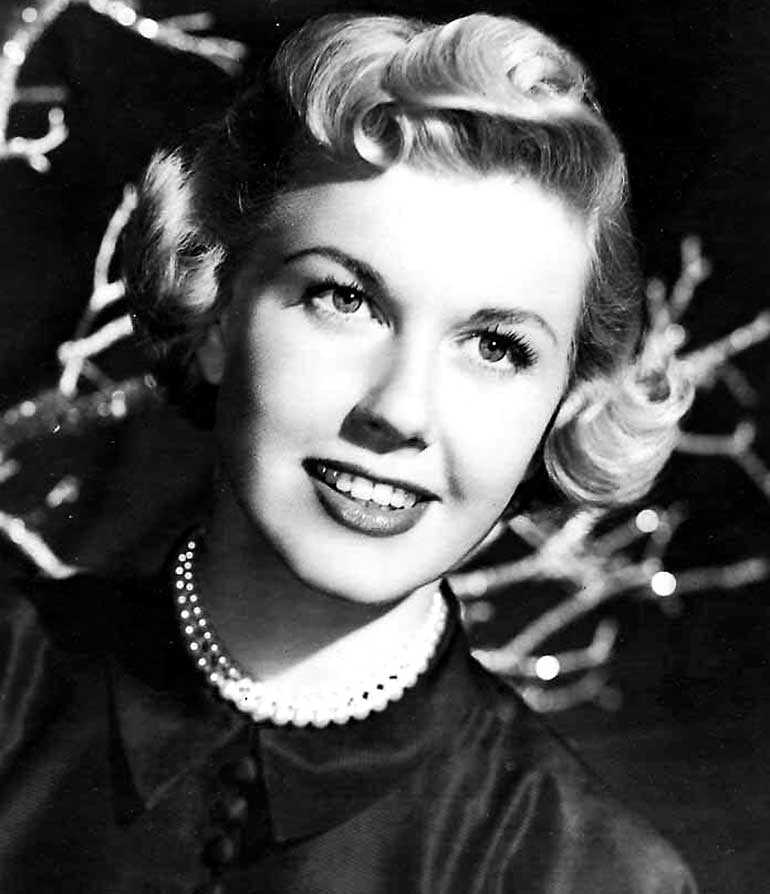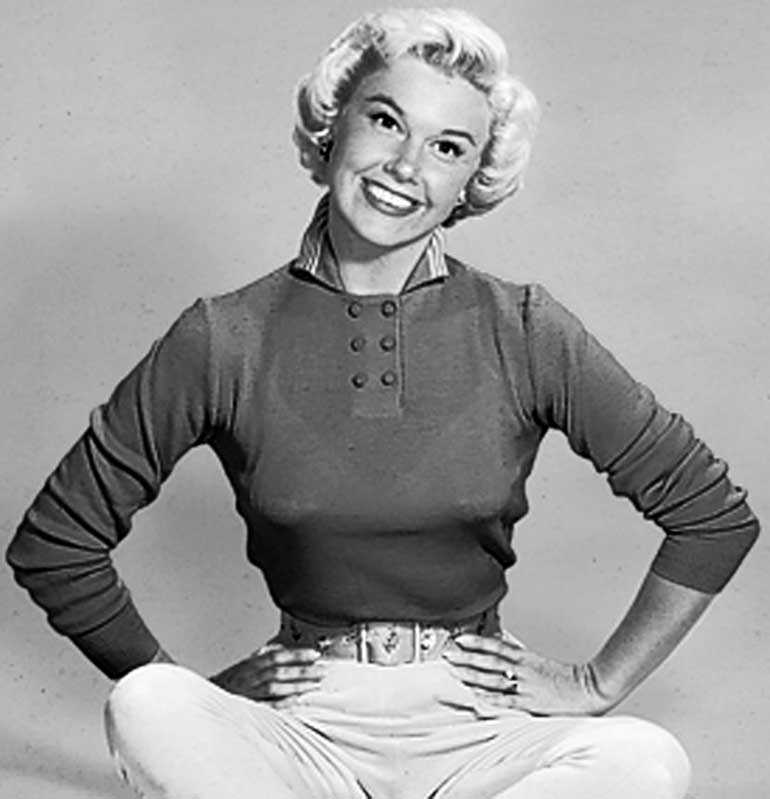Tuesday Aug 26, 2025
Tuesday Aug 26, 2025
Saturday, 27 July 2019 11:00 - - {{hitsCtrl.values.hits}}

Doris Day

When I was just a little kid enrolled at the Santa Maria Montessori school in Wattala, a song we sang without knowing its meaning then was ‘Que Sera Sera’; when I was a boy studying at S. Thomas’ Preparatory School in Kollupitiya, a song we were taught the meaning of and sang loudly in our singing class period was ‘Que Sera Sera’; when I was growing up, passing through various phases of adolescence, a song we frequently sang and heard being sung was ‘Que Sera Sera’; when I entered adulthood and participated in many a high-spirited sing-song session, one song that was sung repeatedly at such gatherings was ‘Que Sera Sera’; when I departed from Sri Lanka and relocated to Canada, a favourite number regularly sung at parties organised by nostalgic Sri Lankans was ‘Que Sera Sera’.
‘Que Sera Sera’ pronounced ‘Kay Sera Sera’ means “Whatever will be, will be” or “What will be, will be”. It is one of the most popular songs to be featured in an English film. It was the well-known singing actress Doris Day who sang it in the film ‘The Man Who Knew Too Much’ released in 1956. The film was directed by the legendary Alfred Hitchcock. It was a revised version of a film, by the same name, made in 1934 by Hitchcock. The song written and composed by the American duo Jay Livingston and Ray Evans became an instant hit.
As the years progressed in Toronto, I acquired a DVD of Alfred Hitchcock’s movie ‘The Man Who Knew Too Much’ as well as a CD of Doris Day numbers and occasionally watched the film or listened to the ever-popular ‘Que Sera Sera’. When Doris Day died last May at the age of 97, I watched DVDs of the actress-singer’s films and listened to her CDs. ‘The Man Who Knew Too Much’ and ‘Que Sera Sera’ figured prominently in that binge of nostalgia. The ‘Spotlight’ column appearing after several weeks focuses therefore on this remarkable song and singer this week.
Doris Day was born on 3 April 1922 as Doris Mary Kappelhoff in Cincinnati, Ohio, USA. Both her parents were of German origin. She adopted the stage name Doris Day and commenced a career in singing. Starting out as a singer on radio and at restaurants, Doris joined popular bands and began recording singles.
The Director Michael Curtiz gave her a break in acting by casting her in the film ‘Romance in the High Seas’. Curtiz felt she had that “all-American girl look”. Doris Day became rapidly popular and was voted favourite star by US servicemen stationed in Korea. She acted in a number of romantic musical comedies. Doris acted with a number of leading Hollywood actors including Rock Hudson with whom she paired off best.
Doris Day was a successful singer cum actress who was the top star of her day in the late fifties and early sixties of the 20th century. She passed away on 13 May 2019. Many of her songs remain as perennial favourites but the widely-popular evergreen number ‘Que Sera Sera’ is adjudged by many as Doris Day’s signature song.
The song ‘Que Sera Sera’ is sung in the first person by a woman in a reflective, pensive frame of mind. It has four verses denoting four phases of her life in progressive order. She is a child, young adult, lover and mother respectively. (In some versions there are only three verses, with the one relating to the teacher being left out.)
In the first three verses she is concerned about her future and asks pointed questions. First as a child she asks her mother, “What will I be?” Next as a student she asks her teacher, “What will I try?” Then as a lover she asks her sweetheart, “What lies ahead?” Finally as a mother she is now asked by her children the same question she once asked her mother, “What will I be?”
There is only one answer to all these questions at various levels – “Whatever will be, will be; the future’s not ours to see. Que sera, sera; what will be, will be,” sung as a chorus.
In the film it is sung twice in parts by Doris Day who plays Josephine Conway a popular singer now married to a medical doctor Benjamin Mckenna played by James Stewart. In an early sequence she sings some verses of the song along with her son. We also see the son Hank whistle the tune loudly. This is of significance later on. These scenes portray the Mackennas as a typical all-American family.
In the climax sequences the song are sung by her again in a tense, suspense-ridden atmosphere. Josephine and Benjamin are honoured guests at the London Embassy of a foreign country while their son is being held prisoner in the same embassy premises. In a melodramatic twist Josephine or Jo gets to sing ‘Que Sera Sera,’ which is heard by the son who whistles the tune loudly, thereby alerting the father, who then manages to rescue him. The song in the film therefore is in two parts. Both have to be combined as one song.
‘The Man Who Knew Too Much’ was a huge commercial success in 1956. The film was produced on a budget of $ 1.2 million but US box office earnings alone amounted to $ 11.2 million. It was also well-received internationally.
The chief attraction of the film was the song ‘Que Sera Sera’. The song won for Jay Livingston and Ray Evans an Oscar for Best Original Song in 1956. The singles record released by Columbia records boomed in sales and topped the charts that year in the UK. In the USA it was No. 2 on ‘Billboard 100’. In 2004 the American Film Institute ranked ‘Que Sera Sera’ as No. 48 among the 100 best songs in American cinema.
‘Que Sera Sera’ gave Ray Evans and Jay Livingston their third Oscar for best original songs in films. The earlier ones were for ‘Buttons and Bows’ in ‘The Paleface’ and ‘Mona Lisa’ in ‘Captain Carey, USA’. Usually Ray Evans wrote the words and Jay Livingston composed the tunes in their collaborative efforts. But in this case much of the lyrics were also written by Jay. How they came to work on the song and how they chose the words ‘Que Sera Sera’ is an interesting tale.
In the book ‘Songwriters on Songwriting’ by Paul Zollo, Ray and Jay state as follows – “We got a call from Alfred Hitchcock. And he told us that he had Doris Day in his picture, whom he didn’t want. But MCA (Music Corporation of America), the agency, was so powerful that they said if he wanted Jimmy Stewart he would also have to take Doris Day and Livingston and Evans. It was the only time an agent got us a job that I can remember. Hitchcock said that since Doris Day was a singer, they needed a song for her. He said, ‘I can tell you what it should be about. She sings it to a boy. It should have a foreign title because Jimmy Stewart is a roving ambassador and he goes all over the world.’”
Though Ray and Jay say Doris Day was imposed upon Hitchcock, the film’s Associate Producer Herbert Coleman was quoted differently in the documentary ‘The Making of The Man Who Knew Too Much’. According to Coleman, Hitchcock had seen the film ‘Storm Warning’ starring Ronald Reagan (US President 1981-’88) and Doris Day and wanted to cast her as his leading lady. It was Coleman who protested and suggested other actresses like Lana Turner, Kim Novak, Jane Russell or Ava Gardner instead. Finally Hitchcock had his way and Doris Day was chosen. This was entirely Hitchcock’s decision. There was no pressure.
A clearer picture of how the song came to be written and picturised in the film is provided in the book ‘Hitchcock’s Music’ by Jack Sullivan. Apparently Paramount Pictures which was to distribute the film had insisted that a song by Doris Day should be included in the film as fans would definitely expect one from the popular singer-actress. Paramount also wanted the song to be written and composed by the Livingston-Evans duo with whom they had a 10-year contract. Hitchcock though reluctant was compelled to agree.
The music score for the film was by Bernard Hermann who was a favourite of Hitchcock, having composed music for several of the director’s movies. It was Hermann who was responsible for the Back Ground Music (BGM) in this film too though Jay and Ray were tasked with the Doris Day number. The renowned director, famous for the suspense in his movies, thought of a sequence where the song on screen would be an integral component of a thrilling climax scene.
Hitchcock told Livingston and Evans: “I don’t know what kind of song I want. But Jimmy Stewart is a roving ambassador and it would be nice if the song had some foreign words in the title. Also, in the picture, I have it set up so that Doris sings to their little boy.”
As stated earlier it was Livingston who generally composed the music while Evans wrote the words. But in this film the order was reversed. It was Jay Livingston who wrote most of the words as well as the tune. What had happened was that in 1954, Livingston had seen the film ‘The Barefoot Contessa’ starring Ava Gardner, Humphrey Bogart and Edmond O’Brien. It was directed by Joseph L. Manckiewicz. In the film the fictional Italian aristocratic family has the motto ‘Che Sara Sara’ carved in stone at their ancestral villa. It is also engraved on the Contessa’s tombstone.
Jay Livingston, struck by the three words ‘Che Sara Sara,’ had written it down – in the darkness of the cinema theatre – in his notebook. He had thought the words were suitable for a song. So when Hitchcock wanted a song title with foreign words, Livingston suggested ‘Che Sara Sara’. It was later changed from Italian to the Spanish ‘Que Sera Sera’. Thereafter the duo plunged zestfully into writing the song with the “inspired” Jay Livingston contributing the most. It was over in three days but Jay and Ray delayed it for two weeks before submitting to Hitchcock.
The director was delighted and so was Paramount but there was a hitch. Paramount Pictures recognised immediately that the song possessed Oscar-winning potential. However the Academy of Motion Picture Arts and Sciences (AMPAS) awarding Oscars would not approve of a song with a ‘foreign’ title. So the title of the song was modified into ‘Whatever Will Be, Will Be (Que Sera Sera)’ in the film and nominated for the Oscars where it struck gold.

Doris Day, however, did not like the song and described it as a “kiddie song”. As she later recollected in an interview to the NPR radio, “I thought I’m not crazy about that. Where are they going to put it? You know, for what? Is it when I put him in bed sometime and I sing that to him or something? I did that in another film. And I thought maybe that’s what it’s going to be. And I just, I didn’t think it was a good song.”
However Alfred Hitchcock and her husband Martin Melcher persuaded Doris Day to record it. Martin, her third husband, was also her manager. So a reluctant Doris Day went through with it and recorded the song in one take. And then she said, “That’s the last you’re going to hear of this song.’”
How wrong she was! Not only did the song win an Oscar but it was also a chart-buster. Furthermore, the song proved to be the greatest hit ever sung by Doris Day.
However in the same NPR interview cited earlier, Doris Day half-heartedly accepted the popularity of the song. She reportedly said: “So maybe it isn’t a favourite song of mine, but people loved it. And kids loved it. And it was perfect for the film. So, you know, I can’t say that it’s a favourite song of mine and I think it’s fabulous but, boy, it sure did something. It came out and it was loved.” How true!
The song beginning “When I was just a little girl, I asked my mother what will I be” had a universal appeal. The song became widely popular within a few years in many different countries. In Sri Lanka, known then as Ceylon, the song – like those of Jim Reeves – became very popular with Western music listeners. Many lips chanted “Que Sera Sera”.
The song was picked up by other linguistic cultures too. Songs with modified variations of the melody and words have appeared in 35 different languages. Among these are French, German, Hungarian, Swedish, Italian, Spanish, Estonian, Polish, Latvian, Yiddish, Japanese, Cantonese and Mandarin versions of the song.
The words ‘Que Sera Sera’ soon acquired a unique appeal of its own. The three memorable words were adopted and adapted in different ways. For instance the Indian film ‘Pukar’ released in Hindi has a dance sequence featuring Madhuri Dixit and Prabhu Deva. The song they danced to was ‘Kay Sera Sera’. The singers were Shankar Mahaevan, Kavita Krishnamurthy and Swarnalatha. The lyricists were Javed Akthar and Majrooh Sultanpuri.
A.R. Rahman composed the music. What Rahman did was to re-utilise the melody of the song ‘Kaadhal Niagara’ from an earlier Tamil film ‘En Swaasak Kaatre’ for the popular Hindi song. Though the tune and words were totally different, the chorus and title of the song was ‘Kay Sera Sera’ derived from the English ‘Que Sera Sera’.
Even the Tamil film ‘Aaravalli’ produced by Modern Theatres in 1957 had a spinoff from ‘Que Sera Sera’. The Tamil song ‘Chinnap Pennaana Poathiley’ sung by the real-life husband and wife pair Jikki-A.M. Rajah remains a perennial favourite. The words were written by Pattukkoattai Kalyanasundaram and music composed by G. Ramanathan. The substitute for ‘Que Sera Sera’ in Tamil were the words ‘Vennilaa, Nilaa’ (Silver Moon, Oh Moon). The versatile Indian actress-singer Dr. Bhanumati Ramakrishna sang verses from the song in English for the Telugu film ‘Thodu Needa’.
Though Doris Day sang many songs on screen and stage and released several records and albums ‘Que Sera Sera’ is regarded as her signature song. When the singer-actress launched her own ‘Doris Day Show’ from 1968 to 1973 on TV, the theme song was ‘Que Sera Sera’. She also sang snippets from the song in some other films she acted in. She sang the song to her co-star David Niven in the film ‘Please Don’t Eat Daisies’. In the film ‘The Glass Bottom Boat,’ she sings to the accompaniment on ukulele by her co-star Arthur Godfrey.
A very interesting aspect of the song’s popularity has been its adaptation into a rousing football chant by the robust soccer fans of Britain. The prestigious FA cup finals in England have been played in Wembley Stadium since 1923. When clubs play each other, partisan fans treat each success as a significant milepost on the road to Wembley or ultimate victory. So when their favourite team triumphs, British fans celebrate by chanting lustily, “Que Sera Sera, Whatever will be will be, We’re going to Wembley, Que sera sera.”
The magical words ‘Que Sera Sera’ are by themselves somewhat fatalistic. What is destined to happen will happen. It cannot be foreseen. Yet the song imbues one with a sense of confidence and courage. Instead of forebodings about an uncertain future, the song instils optimistic hopes. It also says indirectly that there is nothing new in life and that the cycle of life will keep turning – from daughter to mother and mother to daughter. ‘Que Sera Sera’ has been described by some as a song of “cheerful fatalism”.
When I was just a little girl,
I asked my mother, “What will I be?
Will I be pretty?
Will I be rich?”
Here’s what she said to me:
“Que sera, sera,
Whatever will be, will be;
The future’s not ours to see.
Que sera, sera,
What will be, will be.”
When I was just a child in school,
I asked my teacher, “What will I try?
Should I paint pictures,”
Should I sing songs?”
This was her wise reply:
“Que sera, sera,
Whatever will be,
will be;
The future’s not
ours to see.
Que sera, sera,
What will be, will be.”
When I grew up and fell in love.
I asked my sweetheart, “What lies ahead?
Will we have rainbows
Day after day?”
Here’s what my sweetheart said:
“Que sera, sera,
Whatever will be, will be;
The future’s not ours to see.
Que sera, sera,
What will be, will be.”
Now I have children of my own.
They ask their mother, “What will I be?”
Will I be handsome?
Will I be rich?”
I tell them tenderly:
“Que sera, sera,
Whatever will be, will be;
The future’s not ours to see.
Que sera, sera,
What will be, will be.
Que Sera, Sera!
(D.B.S. Jeyaraj can be reached at [email protected].)